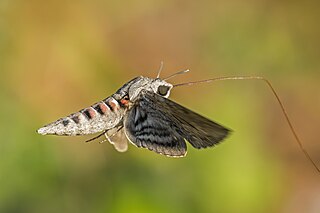
Agrius convolvuli, the convolvulus hawk-moth is a large hawk-moth. It is common throughout Europe, Asia, Africa, Australia and New Zealand, partly as a migrant.

Ctenucha is a genus of moths in the family Erebidae.
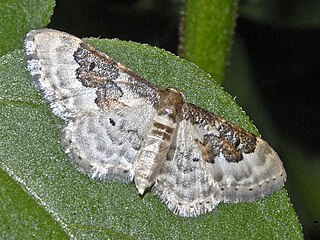
The least carpet is a moth of the family Geometridae.
Anarta is a genus of moths of the family Noctuidae.

Cleora is a genus of moths in the family Geometridae. The genus was erected by John Curtis in 1825.

Erbessa is a genus of moths of the family Notodontidae. It consists of the following species:
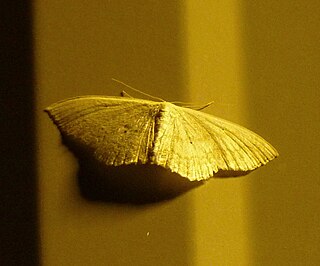
Lomographa glomeraria, the gray spring moth, is a moth of the family Geometridae. The species was first described by Augustus Radcliffe Grote in 1881. It is found in eastern North America, including Alabama, Arkansas, Illinois, Indiana, Maryland, Massachusetts, Michigan, Oklahoma, Ontario, Pennsylvania and Tennessee.
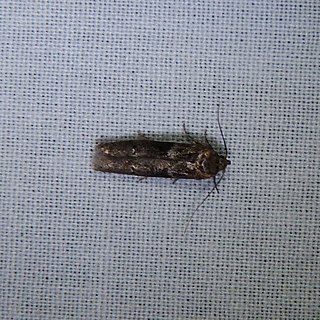
Blastobasis glandulella is a species of moth of the Blastobasidae family. It is found in the eastern United States and southern Ontario, Canada. It has also been recorded in California. In Europe, it has been recorded from Austria, Germany, the Czech Republic, Italy, Slovakia and Croatia.

Actrix nyssaecolella, the tupelo leaffolder moth, is a species of moth of the family Pyralidae described by Harrison Gray Dyar Jr. in 1904. It is found from Michigan and New York to Florida and west to Texas.

Tolype velleda, the large tolype moth or velleda lappet moth, is a species of moth of the family Lasiocampidae. It was first described by Caspar Stoll in 1791. The species is found from Nova Scotia to central Florida, west to Texas and north to Ontario.
Erbessa projecta is a moth of the family Notodontidae. It is found in Brazil.

Diploschizia impigritella, the yellow nutsedge moth or the five-barred glyphipterid moth, is a species of sedge moth in the genus Diploschizia. It was described by James Brackenridge Clemens in 1862. It is found in North America, from Newfoundland to Florida, west to Texas and North Dakota. It has also been recorded from California.
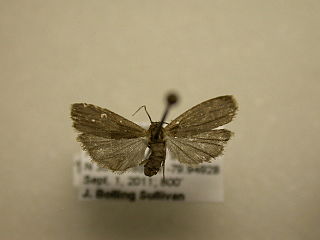
Crambidia lithosioides, the dark gray lichen moth, is a moth of the family Erebidae. It was described by Harrison Gray Dyar Jr. in 1898. It is found in the United States from North Carolina to Florida and from Kentucky to Mississippi.
Ctenucha projecta is a moth of the family Erebidae. It was described by Paul Dognin in 1904. It is found in Paraguay and Peru.

The Esquiline Treasure is an ancient Roman silver treasure that was found in 1793 on the Esquiline Hill in Rome. The hoard is considered an important example of late antique silver work from the 4th century AD, probably about 380 for the major pieces. Since 1866, 57 objects, representing the great majority of the treasure, have been in the British Museum.
Carex projecta, the necklace sedge, is a species of sedge that was first described by Kenneth Mackenzie in 1908.
Patania silicalis, the herbivorous pleuroptya moth, is a moth in the Spilomelinae subfamily of the Crambidae family. It was described by Achille Guenée in 1854. It is found in Brazil, Venezuela, Ecuador, French Guiana, Guyana, Guatemala, Costa Rica, Panama, Mexico, Cuba, Jamaica, Puerto Rico, Hispaniola and North America, where it has been recorded from Missouri, Michigan, Ohio and New York, south to Florida.

Gonioterma is a genus of moths in the subfamily Stenomatinae.
Gonioterma projecta is a moth of the Depressariidae family. It is found in French Guiana.
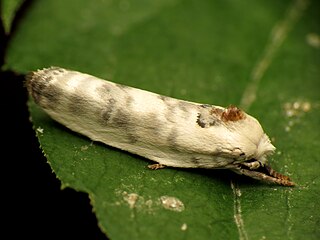
Antaeotricha leucillana, the pale gray bird-dropping moth, is a moth in the family Depressariidae. It was described by Philipp Christoph Zeller in 1854. It is found in North America, where it has been recorded from New Hampshire, Massachusetts, New York, Pennsylvania, District of Columbia, Virginia, North Carolina, Georgia, Alabama, Arkansas, Missouri, Kansas, Illinois, Iowa, Texas, Oregon, Louisiana, Manitoba and Nova Scotia.

















